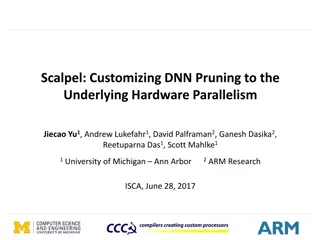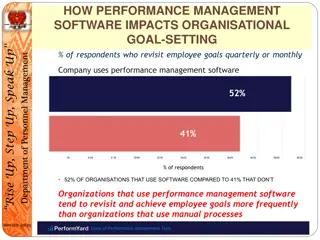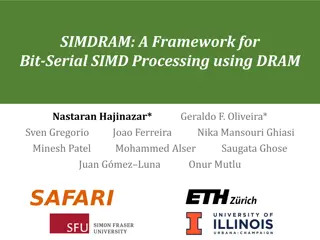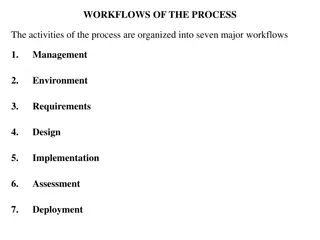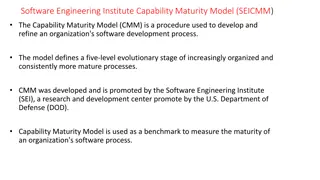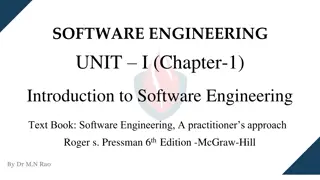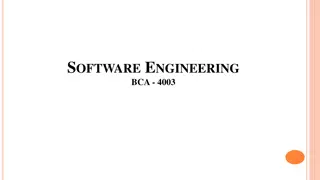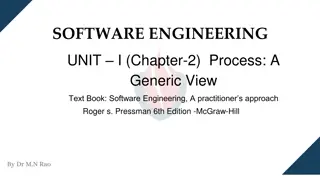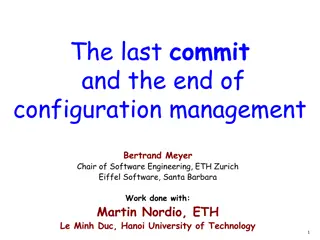Understanding SIMD for High-Performance Software Development
SIMD (Single Instruction Multiple Data) hardware support utilizes vector registers for high-performance computing. Vector instructions operate on multiple data elements simultaneously, offering scalability and efficient processing strategies. The use of wide vector registers enhances arithmetic operations, memory transfers, and alignment requirements, contributing to optimized software development.
Download Presentation

Please find below an Image/Link to download the presentation.
The content on the website is provided AS IS for your information and personal use only. It may not be sold, licensed, or shared on other websites without obtaining consent from the author. Download presentation by click this link. If you encounter any issues during the download, it is possible that the publisher has removed the file from their server.
E N D
Presentation Transcript
SIMD NPRG054 High performance software development - 2015/2016 David Bedn rek 1
SIMD SIMD = Single Instruction Multiple Data Hardware support Vector registers wide registers (64-512 bits), interpretation depends on instructions used in some architectures, (lower) parts of wide registers act as smaller vector (or even scalar) registers (backward compatibility) Vector instructions act on vector registers similarly to normal instructions acting on scalar registers what humans call vectors, hardware sees as scalars logically, each vector instruction performs N mathematical operations at once In most cases, the N lanes act independently physically, the N operations may be executed: all in the same moment, using N hardware units in a pipeline, using single hardware unit (usually divided into stages) combined, feeding N/K batches into K hardware units scalability: different hardware may use different K for the same instruction different instructions use different vector elements (double, float, int64,...,int8) instructions have different N (therefore K) the same hardware (e.g. an adder) is reconfigured into different K s (e.g. by cutting carry) NPRG054 High performance software development - 2015/2016 David Bedn rek 2
Different processing strategies N=8, K=4 N=8, K=8 time Example: Older implementations of AVX Example: Newer implementations of AVX using either a 256-bits wide pipeline or two 128-bit pipelines synchronously Problem: Cross-lane instructions (e.g. shuffles) cannot pass data between the two halves The problem remains visible in the AVX instruction set NPRG054 High Performance Software Development- 2016/2017 David Bedn rek 3
Different lane width N=8, K=4 N=8, K=8 time Example: Single-precision FP in AVX 8*32 = 256 bits N=4, K=4 N=4, K=2 Example: Double-precision FP in AVX 4*64 = 256 bits NPRG054 High Performance Software Development- 2016/2017 David Bedn rek 4
SIMD Hardware support Vector registers Vector instructions Memory transfers in most cases, vector registers must be read/written from/to contiguous blocks of memory existence of vector instructions requires widening of internal data paths in CPU similarly to arithmetics, one vector may be transferred either at once or as a series of smaller batches (since ultra-wide data paths are expensive) the batches (usually) originate in the same cache line only one cache lookup needed even if the data paths were not wider than a scalar, vector transfers would be faster there are soft or hard requirements for alignment Align to data path width (16/32 bytes in current Intel/AMD CPUs) Do not cross cache line boundaries (64 bytes in all current Intel/AMD CPUs) NPRG054 High performance software development - 2015/2016 David Bedn rek 5
SIMD Software support Automatic vectorization by compilers The transformation is often non-equivalent wrt. strict language rules Explicit permission from the programmer is needed (pragma) Advanced transformation methods now called polyhedral compilation (e.g. Polly/LLVM) Vectorized library code Operations on arrays/matrices implemented using vector instructions Explicit use of vector datatypes and instructions Make use of all instructions available, including peculiarities In assembly languages error prone and often worse than product of compilers In higher languages using intrinsic functions Compilers take care of register allocation, addressing, type safety, etc. Handling alignment requirements All parts (programmers, compilers, libraries) must cooperate to make data properly aligned NPRG054 High performance software development - 2015/2016 David Bedn rek 6
SIMD in Intel/AMD x64 SIMD support in Intel/AMD CPUs MMX (Intel 1997) 64 bits, 8 registers (MM0..7), shared with scalar floating-point unit (x87) only integer operations (8/16/32-bit), targeted at audio processing AMD 3DNow added some 32-bit floating point support SSE (Intel 1999) 128 bits, 8 registers (XMM0..7), only 32-bit floating point supported SSE2-SSE4 (Intel 2001-2007) 64-bit floating-point and 8/16/32/64-bit integer arithmetics for 128-bit vectors x64 (AMD 2003) additional 8 registers (XMM8..15) available in 64-bit mode AVX (Intel/AMD 2011) 256 bits, 16 registers (YMM0..15) (only YMM0..7 accessible in 32-bit mode) floating point (32/64-bit) operations only three-operand instruction format AVX2 (Intel 2013) integer arithmetics (8/16/32/64-bits) extended to 256-bit vectors gather/maskstore instructions NPRG054 High performance software development - 2015/2016 David Bedn rek 7
SIMD in Intel/AMD x64 SIMD support in Intel/AMD CPUs AVX (Intel/AMD 2011) 256 bits, 16 registers (YMM0..15) (only YMM0..7 accessible in 32-bit mode) floating point (32/64-bit) operations only three-operand instruction format AVX2 (Intel 2013) integer arithmetics (8/16/32/64-bits) extended to 256-bit vectors gather/maskstore instructions IMCI (Intel 2012) in Intel Knights Corner architecture (aka. MIC aka. Xeon Phi) 512 bits, 32 registers (ZMM0..31) gather/scatter instructions mask registers AVX512 (Intel 2016) in Intel Knights Landing (aka. MIC 2 aka. Xeon Phi second generation) in Intel Skylake Purley (2017), Cannonlake (2018) most instructions equivalent to IMCI (but different binary encoding) NPRG054 High performance software development - 2015/2016 David Bedn rek 8
SIMD Advantages of SIMD Greater arithmetic throughput double-precision multiply on Skylake: 2*4 operations per clock cycle (vs. 2 scalar) fused multiply-add (FMA): 2*4 muls + 2*4 adds per clock 32-bit integer addition on Skylake: 3*8 operations per clock (vs. 4 scalar) Greater memory throughput Only vector instructions can use the full 256-bit width of CPU-L1 bus Vector throughput: 64B loads + 32B stores per clock Scalar double-precision throughput: 16B loads + 8B stores Greater register file scalar x64 integer: 16*64bit = 128 bytes scalar extended-double-precision: 8*80bit = 80 bytes AVX2: 16*256bit = 512 bytes AVX512: 32*512bit = 2048 bytes for comparison: Xeon Phi L1 Cache = 64 KB shared by 4 threads = 16 KB per thread NPRG054 High performance software development - 2015/2016 David Bedn rek 9
Vector data types and registers (MMX/SSE/AVX/AVX512) NPRG054 High performance software development - 2015/2016 David Bedn rek 10
Integer registers 8 bit CPU A HL BC DE SP FLAGS PC 1974 Intel 8080 12 B of registers 64 KB addressable memory NPRG054 High Performance Software Development- 2016/2017 David Bedn rek 11
Integer registers 8 bit CPU A HL BC DE IX IY SP FLAGS PC 1976 Zilog Z80 16 B of (app) registers 64 KB addressable memory NPRG054 High Performance Software Development- 2016/2017 David Bedn rek 12
Integer registers 16 bit mode AX BX CX DX SI DI BP SP FLAGS IP 1978 Intel 8086 20 B of (app) registers 1 MB addressable memory NPRG054 High Performance Software Development- 2016/2017 David Bedn rek 13
Integer and FPU registers 16 bit mode AX BX CX DX SI DI BP SP FLAGS IP 1980 Intel 8086+8087 100 B of (app) registers 1 MB addressable memory ST 8 80-bit FP registers in co-processor chip (8087) ST NPRG054 High Performance Software Development- 2016/2017 David Bedn rek 14
Integer and FPU registers 32 bit mode EAX EBX ECX EDX ESI EDI EBP ESP this picture is shown with MSB on the left EFLAGS EIP 1985 Intel 80386+80387 120 B of app registers 4 GB addressable memory ST ST NPRG054 High Performance Software Development- 2016/2017 David Bedn rek 15
Integer and FPU registers 32 bit mode EAX EBX ECX EDX ESI EDI EBP ESP this picture is shown with MSB on the left EFLAGS EIP 1989 Intel 80486 120 B of app registers 4 GB addressable memory ST The FPU is now on the same chip ST NPRG054 High Performance Software Development- 2016/2017 David Bedn rek 16
Scalar and vector registers (MMX) 32 bit mode EAX EBX ECX EDX ESI EDI EBP ESP this picture is shown with MSB on the left (lane 0 on the right) EFLAGS EIP 1997 Intel Pentium MMX 120 B of app registers 4 GB addressable memory ST MM0 64-bit MMX registers were carved from the 80-bit FP registers (x87) ST MM7 NPRG054 High Performance Software Development- 2016/2017 David Bedn rek 17
Scalar and vector registers (MMX/SSE) 32 bit mode XMM0 EAX EBX ECX EDX ESI EDI EBP ESP this picture is shown with MSB on the left (lane 0 on the right) XMM7 EFLAGS EIP 1999 Intel Pentium III 248 B of app registers 4 GB addressable memory ST MM0 64-bit MMX registers were carved from the 80-bit FP registers (x87) ST MM7 NPRG054 High Performance Software Development- 2016/2017 David Bedn rek 18
Scalar and vector registers (MMX/SSE) 64 bit mode XMM0 RAX RBX RCX RDX RSI RDI RBP RSP R8 R9 R10 R11 R12 R13 R14 R15 this picture is shown with MSB on the left (lane 0 on the right) XMM7 XMM8 XMM/YMM8-15 and R8-15 available only in the 64-bit execution mode XMM15 RFLAGS RIP 2003 AMD Opteron 480 B of app registers 1 TB addressable memory ST MM0 64-bit MMX registers were carved from the 80-bit FP registers (x87) ST MM7 NPRG054 High Performance Software Development- 2016/2017 David Bedn rek 19
Scalar and vector registers (IMCI) ZMM0 RAX RBX RCX RDX RSI RDI RBP RSP R8 R9 R10 R11 R12 R13 R14 R15 this picture is shown with MSB on the left (lane 0 on the right) The first Knights Corner CPUs were derived from a Pentium core converted to 64 bits and had no support for SSE or MMX 2010 Intel Xeon Phi Knights Corner 2272 B of app registers per thread RFLAGS RIP ST ST ZMM31 NPRG054 High Performance Software Development- 2016/2017 David Bedn rek 20
Scalar and vector registers (MMX/SSE/AVX) YMM0 XMM0 RAX RBX RCX RDX RSI RDI RBP RSP R8 R9 R10 R11 R12 R13 R14 R15 this picture is shown with MSB on the left (lane 0 on the right) YMM7 YMM8 XMM7 XMM8 XMM/YMM8-15 and R8-15 available only in the 64-bit execution mode YMM15 XMM15 RFLAGS RIP 2011 Intel Sandy Bridge 736 B of app registers per thread 1 TB addressable memory ST MM0 ST MM7 NPRG054 High Performance Software Development- 2016/2017 David Bedn rek 21
Scalar and vector registers (MMX/SSE/AVX/AVX512) ZMM0 YMM0 XMM0 RAX RBX RCX RDX RSI RDI RBP RSP R8 R9 R10 R11 R12 R13 R14 R15 this picture is shown with MSB on the left (lane 0 on the right) ZMM7 ZMM8 YMM7 YMM8 XMM7 XMM8 K1 K2 K3 K4 K5 K6 K7 AVX512 mask registers 2013 Intel Xeon Phi Knights Landing 2286 B of app registers per thread ZMM15 ZMM16 YMM15 YMM16 XMM15 XMM16 RFLAGS RIP ST MM0 ST MM7 ZMM31 YMM31 XMM31 NPRG054 High Performance Software Development- 2016/2017 David Bedn rek 22
Vector data types (MMX/SSE/AVX/AVX512) AVX512 512 bits assembler instruction suffix (Intel) C intrinsic function suffix AVX 256 bits this picture is shown in the memory order (lane 0 on the left) SSE 128 bits MMX 64 bits PD pd double double double double double double double double PS ps float float float float float float float float float float float float float float float float DQ or none Q epi128/si128 128 128 128 128 only bitwise and/or/xor and shift instructions epi64 (signed) epu64 (unsigned) 64 64 64 64 64 64 64 64 D epi32 (signed) epu32 (unsigned) 32 32 32 32 32 32 32 32 32 32 32 32 32 32 32 32 W epi16 (signed) epu16 (unsigned) 16 16 16 16 16 16 16 16 16 16 16 16 16 16 16 16 16 16 16 16 16 16 16 16 16 16 16 16 16 16 16 16 B epi8 (signed) epu8 (unsigned) 88888888 88888888888888888888888888888888888888888888888888888888 NPRG054 High Performance Software Development- 2016/2017 David Bedn rek 23
Floating-point vector data types (MMX/SSE/AVX/AVX512) AVX512 512 bits assembler instruction suffix (Intel) C intrinsic function suffix AVX 256 bits SSE 128 bits PD pd double double double double double double double double PS ps float float float float float float float float float float float float float float float float AVX-512_BF16 - since Cooper Lake (Intel 2020): BF16 pbh 16 16 16 16 16 16 16 16 16 16 16 16 16 16 16 16 16 16 16 16 16 16 16 16 16 16 16 16 16 16 16 16 AVX-512_FP16 - since Sapphire Rapids (Intel 2023): PH ph 16 16 16 16 16 16 16 16 16 16 16 16 16 16 16 16 16 16 16 16 16 16 16 16 16 16 16 16 16 16 16 16 Bits shown with MSB on the left; opposite of the memory order: pd = IEEE 754 Double S E E E E E E E E E E E M M M M M M M M M M M M M M M M M M M M M M M M ... ps = IEEE 754 Single S E E E E E E E E M M M M M M M M M M M M M M M M M M M M M M M pbh S E E E E E E E E M M M M M M M ph = IEEE 754 Half S E E E E E M M M M M M M M M M NPRG054 High Performance Software Development- 2016/2017 David Bedn rek 24
Vector instructions (SSE/AVX/AVX512) NPRG054 High performance software development - 2015/2016 David Bedn rek 25
Vector instructions (SSE/AVX/AVX512) Memory access Loads and stores In addition, many other instructions may have up to 1 memory operand Plain arithmetic instructions Parallel execution of the same operation in each lane, independently Conditions and masks Support for conditional execution, independently in each lane Inter-lane arithmetics Applying selected operations across lanes Inter-lane shuffles Movement of data between lanes Conversions Changing widths of data; interaction with scalar registers The list in these slides can never be complete, see the reference: https://www.intel.com/content/www/us/en/docs/intrinsics-guide/index.html NPRG054 High Performance Software Development- 2016/2017 David Bedn rek 26
Vector instructions (SSE/AVX/AVX512) Memory access Vector load and stores Load/store vector from/to a consecutive block of memory load/store - Aligned loads/stores fault if unaligned to a multiple of 16B loadu/storeu - Unaligned load/stores slower if unaligned In older architectures, slower even if aligned use only if alignment cannot be guaranteed stream_load - Non-temporal loads not stored in caches (where architecture allows) To avoid cache pollution when the data will not be read again soon Memory arguments of vector instructions At most one argument may reside in memory In SSE, the memory argument must always be aligned to 16B In AVX-enabled CPUs, memory arguments may be unaligned (resulting in slower operation) Applies also to SSE instructions, if VEX-encoded (assembler names prefixed by V ) When used from C/C++ The compiler automatically generates loadu/storeu (or memory arguments if AVX is enabled) whenever working with memory operands If alignment is guaranteed, explicit load/store to a local variable usually produces faster code NPRG054 High Performance Software Development- 2016/2017 David Bedn rek 27
Vector instructions (SSE/AVX/AVX512) Memory access and data types Formally, a vector load/store of a particular width (128/256/512 bits) just moves the bits between memory and a (XMM/YMM/ZMM) register, independently of the lane size and format Physically, floating-point vectors may be routed through different parts of the CPU than integer vectors And, in theory, different lane widths may also have different pathways This arrangement makes the data closer to the respective hardware units for the following/preceding arithmetic instructions Therefore, there are (at least) three kinds of instructions for loads/stores And even more intrinsic functions mapped to them *MOVDQ(A|U) = *(load|store)[u]_[e]si(32|64|128) = integer loads/stores *MOV(A|U)PS = *(load|store)[u]_ps = float loads/stores *MOV(A|U)PD = *(load|store)[u]_pd = double loads/stores Always use the form of load/store related to the arithmetic instructions which operate on the data With intrinsic functions in C/C++, this is enforced by the existence of different data types representing integer/float/double vectors In assembly language, there is no enforcement NPRG054 High Performance Software Development- 2016/2017 David Bedn rek 28
Vector instructions (SSE/AVX/AVX512) Memory access Gather/scatter Gather available from AVX2, scatter only for AVX512 (and KNC) Load/store lanes of a vector from/to individually indexed positions Available only for 32 or 64 bit data elements Addresses computed by adding a common base address and (the 1/2/4/8-multiple of) an 32/64 bit index in the corresponding lane of a vector register Index and data register may differ in size (e.g., _mm256_i32gather_epi64 reads indexes from a 128-bit register and stores to a 256-bit) The CPU may perform individual lane loads/stores in parallel if they do not hit the same parts of the internal memory buses similar to the notion of stride in GPUs but far less massive In any case, gather/scatter is slower than contiguous loads/stores But faster than a series of scalar load/stores Gather: for (i in 0..N-1) v[i] = a[c*x[i]] c is a constant of 1/2/4/8 For scatter, individual lanes may be masked by a bit-mask: for (i in 0..N-1) if (m[i]) a[c*x[i]] = v[i] Beware: If two indexes are identical in the same scatter, the result is undefined Use *conflict* instructions (in AVX512CD) to detect, then masking to avoid NPRG054 High Performance Software Development- 2016/2017 David Bedn rek 29
Vector instructions (SSE/AVX/AVX512) Plain arithmetic instructions Parallel execution of the same operation in each lane, independently for (i in 0..N-1) c[i] = f(a[i],b[i]) Integer arithmetics: ADD, SUB in 8/16/32/64 bit lanes Saturated signed/unsigned ADD/SUB in 8/16 bit lanes Shifts in 16/32/64/128 bit lanes MUL in 32/64 bit lanes Floating-point arithmetics (32/64-bit lanes) ADD, SUB, MUL, DIV FMA (fused multiply-add) d[i] = c[i] + a[i]*b[i] DP (dot product) with extension pbh->ps d[i] = c[i] + a[2*i]*b[2*i] + a[2*i+1]*b[2*i+1] NPRG054 High Performance Software Development- 2016/2017 David Bedn rek 30
Vector instructions (SSE/AVX/AVX512) Conditions and masks Support for conditional execution, independently in each lane SSE and AVX Comparisons produce all-ones (-1) or all-zeros (0) in each lane Only EQ and GT supported for integers, the others must be derived All six comparisons supported for floating point Conditional expressions are simulated using bitwise AND, ANDNOT, and OR: BEWARE: ANDNOT negates the FIRST argument before anding // for (i in 0..N-1) e[i] = a[i] == b[i] ? c[i] : d[i] cond = cmpeq(a,b) // cond[i] = a[i] == b[i] ? -1 : 0 left = and(cond,c) // left = cond & c right = andnot(cond,d) // right = ~cond & d e = or(left,right) // e = left | right The three bitwise operators come in three flavors, depending on type The reason is the same as for loads/stores *P(AND|ANDN|OR) = *(and|andnot|or)_si128 *(AND|ANDN|OR)PS = *(and|andnot|or)_ps *(AND|ANDN|OR)PD = *(and|andnot|or)_pd NPRG054 High Performance Software Development- 2016/2017 David Bedn rek 31
Vector instructions (SSE/AVX/AVX512) Conditions and masks Support for conditional execution, independently in each lane AVX512 7 special mask (K) registers containing single bit for each lane The number of lanes used depend on the instruction Presented as types __mmask[8|16|32|64] in C/C++ Comparisons produce one bit for each lane All six comparisons supported for all types Almost all instructions have masked variants The instruction is applied for the lanes which have 1 in the corresponding mask operand lane In the other lanes, the result register retains the previous value Comparison instructions may be masked too used to simulate Boolean conjunction In C/C++ intrinsics, masking is presented in two forms mask two additional inputs: previous value vector src and mask vector k: for (i in 0..N-1) r[i] = k[i] ? f(a[i],b[i]) : src[i] maskz one additional input: mask vector k, masked lanes produce zero: for (i in 0..N-1) r[i] = k[i] ? f(a[i],b[i]) : 0 Conditional expressions and statements are simulated using masking: The same mechanism is used in GPUs // for (i in 0..N-1) e[i] = a[i] == b[i] ? c[i] : d[i] cond = cmpeq(a,b) // cond is a mask register e = mask_mov(right,cond,left) // e[i] = cond[i] ? left : right NPRG054 High Performance Software Development- 2016/2017 David Bedn rek 32
Vector instructions (SSE/AVX/AVX512) Inter-lane arithmetics Applying selected operations across lanes hadd/hsub - Horizontal ADD/SUB (16/32/float/double lanes) SSE version: for(i in 0..N/2-1) { r[i] = f(a[2*i],a[2*i+1]) r[N/2 + i] = f(b[2*i],b[2*i+1]) } AVX version acts as applying SSE version to each half of the vectors A consequence of implementing AVX using 128-bit pipelines for(i in 0..N/4-1) { r[i] = f(a[2*i],a[2*i+1]) r[N/4 + i] = f(b[2*i],b[2*i+1]) r[N/2 + i] = f(a[N/2 + 2*i],a[N/2 + 2*i+1]) r[N*3/4 + i] = f(b[N/2 + 2*i],b[N/2 + 2*i+1]) } Effectively swaps the middle two quarters wrt. the naturally expected behavior There is no AVX512 version, operands must be first split into pairs of AVX vectors NPRG054 High Performance Software Development- 2016/2017 David Bedn rek 33
Vector instructions (SSE/AVX/AVX512) Inter-lane shuffles Movement of data between lanes BEWARE: Most AVX/AVX512 shuffle instructions cannot move data between the 128-bit halves/quarters of the vectors Consequence of the original implementation using 128-bit pipelines Use permute2f128 for movement across AVX halves, permute4f128 for AVX2 A vector-wide shuffle must be combined from permute and a 128-wide shuffle *alignr_epi8 byte-granular shift right concatenate two 128-bit vectors, then pick 128 bits at the specified location the shift amount must be a constant (embedded into the instruction) AVX512: *alignr_epi(32|64) 4/8-byte-granular shift right works smoothly across 128-bit boundaries *permute*, *shuffle* arbitrary permutations unary cases for (i in 0..N-1) r[i] = a[p[i]] binary cases for (i in 0..N-1) r[i] = (p[i]&TOP_BIT) ? b[p[i]&LOW_BITS] : a[p[i]&LOW_BITS] many variants differing in granularity and other limitations most variants require permutation encoded in a constant, few accept run-time values NPRG054 High Performance Software Development- 2016/2017 David Bedn rek 34
Vector instructions (SSE/AVX/AVX512) Conversions Changing widths of data; interaction with scalar registers *extract* - copy selected lane into a scalar register (or smaller vector register) the lane index must be a constant *insert* - copy a scalar value into a selected lane of a vector register the rest remains untouched, therefore there is an input vector too the lane index must be a constant *broadcast* - copy a scalar value (or a smaller vector) into all lanes Pseudo-intrinsic functions (not single instructions) in C/C++ *set1* - same as broadcast (where not in instruction set) *setzero* - set all lanes to zero *cast* - conversion between various vector forms (no runtime operation) NPRG054 High Performance Software Development- 2016/2017 David Bedn rek 35
Using MMX/SSE/AVX intrinsics in C/C++ NPRG054 High performance software development - 2015/2016 David Bedn rek 36
Using MMX/SSE/AVX intrinsics in C/C++ Intrinsic functions Formally declared in header files Recognized by the compiler Most intrinsic functions expand to one vector instruction Some functions are implemented using more than one scalar or vector instruction De-facto standard dictated by Intel and copied by MSVC, gcc, and others Data types Declared in header files together with functions Names are standardized, but contents is different (use only as black boxes) Data types correspond to vector register types (widths) __m64, __m128, __m256, __m512 For some type safety, there are three types for each width single-precision (no suffix) double-precision (suffix d ) half-precision (suffix 'bh' for BF16 or 'h' for IEEE 754 Half) all integer widths (suffix i , except of __m64) NPRG054 High performance software development - 2015/2016 David Bedn rek 37
Using MMX/SSE/AVX intrinsics in C/C++ header file types functions technology mmintrin.h __m64 MMX xmmintrin.h __m128 _mm_*_ps SSE emmintrin.h __m128d, __m128i _mm_*_pd _mm_*_ep(i|u)(8|16|32|64) SSE2 pmmintrin.h _mm_*_p(s|d) SSE3 tmmintrin.h _mm_*_epi(8|16|32) SSSE3 smmintrin.h _mm_*_* SSE4.1 nmmintrin.h _mm_cmp*, _mm_crc32_*, _mm_popcnt_u(32|64) SSE4.2 wmmintrin.h _mm_aes*_si128 immintrin.h __m256, __m256d, __m256i _mm256_* AVX, AVX2 __m512, __m512d, __m512i _mm512_* AVX512 ammintrin.h _mm_*, _mm256_* AMD extensions NPRG054 High performance software development - 2015/2016 David Bedn rek 38
Using MMX/SSE/AVX intrinsics in C/C++ Alignment It is recommended to align all vectors to 16 bytes. If not 16-byte aligned: SSE-only CPUs: segfault except for MOVUPS (loadu/storeu) AVX-enabled CPUs: reduced throughput, no segfault (even with SSE instructions) It is advisable to align AVX2 vectors to 32 bytes and AVX512 vectors to 64 bytes avoid splitting over cache-line boundary (a split load counts as two loads) Compiler support When vector types are used for static or local variables or their parts, the compiler will align them (to 16 bytes) __m256i v1; __m256i v2[4]; std::array<__m256i,4> v3; // everything aligned to 16 When vectors are simulated as arrays of scalar types, variables are unaligned std::int32_t v1[8]; // aligned only to 4 bytes!!! alignment may be enforced by alignas(16) Library support C++ library (containers, smart pointers) align correctly only since C++17 std::vector<__m256i> v4; // aligned only to 8 bytes before C++17 Before C++17 (or in C), alignment is done via semi-standardized functions _mm_malloc, posix_memalign, std::align NPRG054 High performance software development - 2015/2016 David Bedn rek 39
Using MMX/SSE/AVX intrinsics in C/C++ Alignment alignas specifier Attached to class/struct types struct alignas(16) aligned_chunk { std::int32_t a[4]; }; Attached to variables (including class/struct members) alignas(16) std::int32_t v1[8]; Notes Alignment on dynamic allocation cannot be enforced when allocating primitive types std::vector<alignas(16) std::int32_t> // SYNTAX ERROR NPRG054 High performance software development - 2015/2016 David Bedn rek 40
Using MMX/SSE/AVX intrinsics in C/C++ Correcting alignment at run time Determine alignment using (p % 16) requires reinterpret_cast to std::intptr_t beware: reinterpret_cast may violate aliasing rules of C++ (C++23: use std::launder) When working on one unaligned array Initial and final unaligned elements processed in scalars, the rest in vectors When working on more unaligned arrays One of the arrays (preferably the output one) dictates alignment Write initial/final elements as scalars, the rest as vectors The other arrays: Either read/written unaligned (requires AVX-enabled CPUs) Or use alignr to extract the matching arguments from a pair of aligned vectors Problem: alignr requires a constant as the shift amount Code must be replicated for every possible value of alignment (may be too many) Complex templated machinery in C++ may be used Problem #2: AVX version of alignr works independently on 16-byte halves This is a consequence of (original) implementation using pipelined 128-bit ALU Use another instruction (permute2f128) before alignr NPRG054 High performance software development - 2015/2016 David Bedn rek 41












